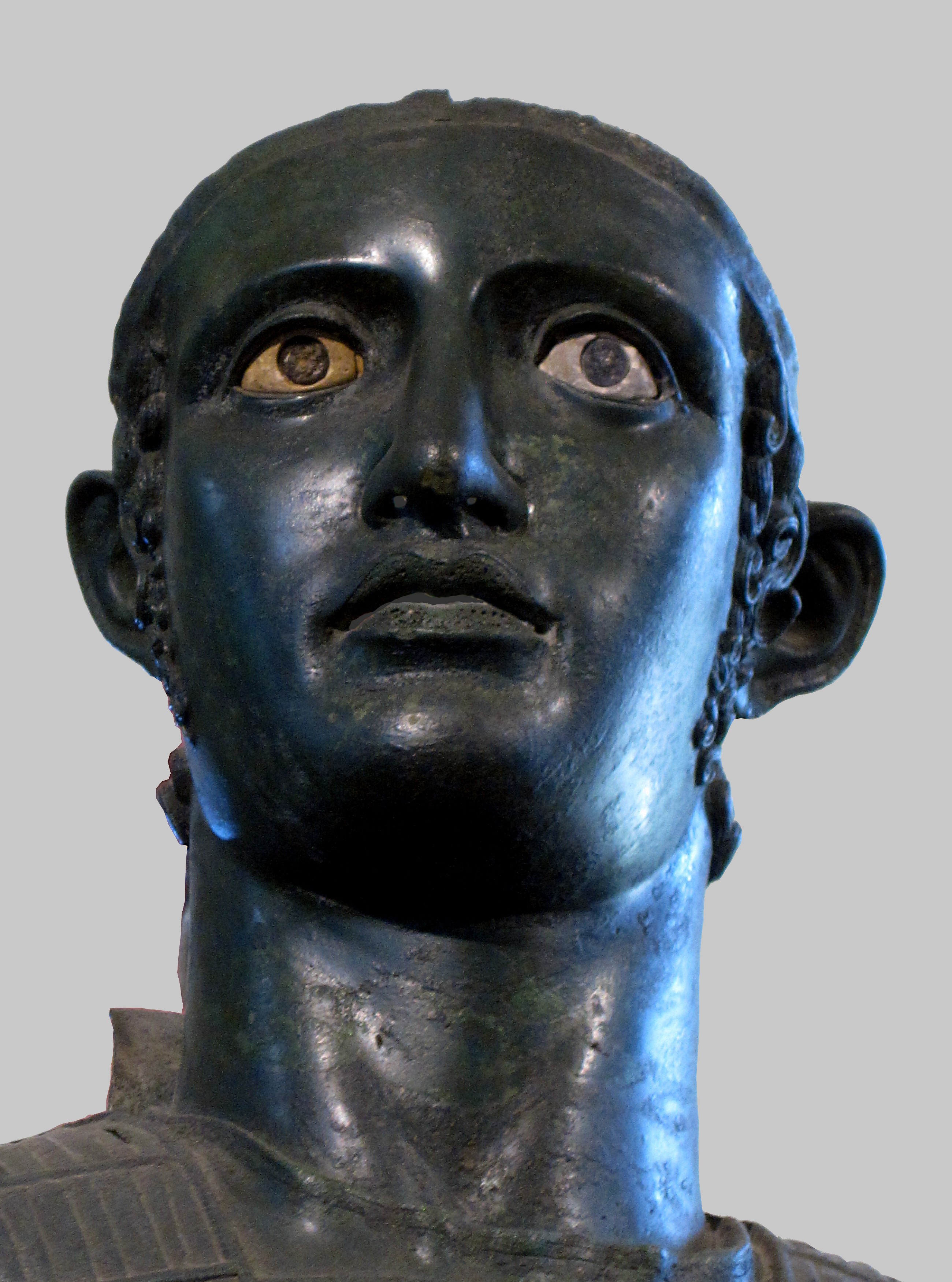Mars Of Todi on:
[Wikipedia]
[Google]
[Amazon]
The so-called ''Mars of Todi'' is a near life-sized  The work is a "typical military figure" with "conspicuously Etruscan" facial features. It is an Etruscan realization of Greek formal Classicism, and makes use of the
The work is a "typical military figure" with "conspicuously Etruscan" facial features. It is an Etruscan realization of Greek formal Classicism, and makes use of the
bronze
Bronze is an alloy consisting primarily of copper, commonly with about 12–12.5% tin and often with the addition of other metals (including aluminium, manganese, nickel, or zinc) and sometimes non-metals, such as phosphorus, or metalloids such ...
warrior, dating from the late 5th or early 4th century BC, produced in Etruria
Etruria () was a region of Central Italy, located in an area that covered part of what are now most of Tuscany, northern Lazio, and northern and western Umbria.
Etruscan Etruria
The ancient people of Etruria
are identified as Etruscan civiliza ...
for the Umbria
it, Umbro (man) it, Umbra (woman)
, population_note =
, population_blank1_title =
, population_blank1 =
, demographics_type1 =
, demographics1_footnotes =
, demographics1_title1 =
, demographics1_info1 =
, ...
n market. It was found at Todi
Todi () is a town and ''comune'' (municipality) of the province of Perugia (region of Umbria) in central Italy. It is perched on a tall two-crested hill overlooking the east bank of the river Tiber, commanding distant views in every direction.
I ...
(ancient Tuder), on the slope of Mount Santo.
The bronze warrior was an expensive votive offering
A votive offering or votive deposit is one or more objects displayed or deposited, without the intention of recovery or use, in a sacred place for religious purposes. Such items are a feature of modern and ancient societies and are generally ...
made at a religious sanctuary, possibly to Laran
In Etruscan mythology and religion, Laran (or Larun) is the god of war. In art, he was portrayed as a naked youth wearing a helmet, a cuirass and carrying a spear, shield, or lance. Laran also appears to be an underworld god. Among his attribut ...
, the Etruscan god of war. It had been buried in antiquity, perhaps ritually, and left undisturbed until its discovery in 1835. It is an example of the highest-quality "prestige" works from Etruria found in Umbria during this period, and probably came from a workshop in Orvieto
Orvieto () is a city and ''comune'' in the Province of Terni, southwestern Umbria, Italy, situated on the flat summit of a large butte of volcanic tuff. The city rises dramatically above the almost-vertical faces of tuff cliffs that are compl ...
(Etruscan Velzna, Roman Volsinii
Volsinii or Vulsinii (Etruscan: Velzna or Velusna; Greek: Ouolsinioi, ; ), is the name of two ancient cities of Etruria, one situated on the shore of Lacus Volsiniensis (modern Lago di Bolsena), and the other on the Via Clodia, between Clusium (C ...
). Velzna was known for its bronze sculptures, more than 2,000 of which were looted by the Romans in 265 BC.
 The work is a "typical military figure" with "conspicuously Etruscan" facial features. It is an Etruscan realization of Greek formal Classicism, and makes use of the
The work is a "typical military figure" with "conspicuously Etruscan" facial features. It is an Etruscan realization of Greek formal Classicism, and makes use of the contrapposto
''Contrapposto'' () is an Italian term that means "counterpoise". It is used in the visual arts to describe a human figure standing with most of its weight on one foot, so that its shoulders and arms twist off-axis from the hips and legs in the a ...
posture. The figure probably held a ''patera
In the material culture of classical antiquity, a ''phiale'' ( ) or ''patera'' () is a shallow ceramic or metal libation bowl. It often has a bulbous indentation ('' omphalos'', "bellybutton") in the center underside to facilitate holding it, ...
'' (libation bowl) in his extended right hand, and a spear in the left. His helmet is missing, but his intricate body armor, depicted with "pedantic accuracy," is one of the best examples showing what lamellar
A ''lamella'' (plural ''lamellae'') is a small plate or flake, from the Latin, and may also be used to refer to collections of fine sheets of material held adjacent to one another, in a gill-shaped structure, often with fluid in between though s ...
plate armor from the period looked like.
The dedication is inscribed on the skirt of the breastplate. It is written in Umbrian
Umbrian is an extinct Italic language formerly spoken by the Umbri in the ancient Italian region of Umbria. Within the Italic languages it is closely related to the Oscan group and is therefore associated with it in the group of Osco-Umbrian lan ...
in Etruscan characters and marks the beginning of the epigraphic tradition in this part of Umbria. The man dedicating it, however, has a name that is Celtic
Celtic, Celtics or Keltic may refer to:
Language and ethnicity
*pertaining to Celts, a collection of Indo-European peoples in Europe and Anatolia
**Celts (modern)
*Celtic languages
**Proto-Celtic language
* Celtic music
*Celtic nations
Sports Fo ...
in origin, an indication of Tuder's "cosmopolitian" character in the Archaic period. The inscription reads ''Ahal Trutitis dunum dede'', "Ahal Trutitis gave his as agift".
The sculpture is currently held by the Museo Etrusco Gregoriano of the Vatican
Vatican may refer to:
Vatican City, the city-state ruled by the pope in Rome, including St. Peter's Basilica, Sistine Chapel, Vatican Museum
The Holy See
* The Holy See, the governing body of the Catholic Church and sovereign entity recognized ...
.
References
{{commons category 5th-century BC sculptures 4th-century BC sculptures 1835 archaeological discoveries Archaeological discoveries in Italy Etruscan sculptures Bronze sculptures